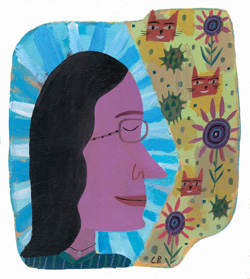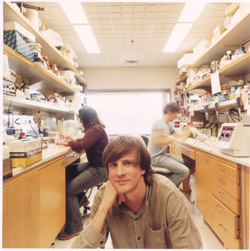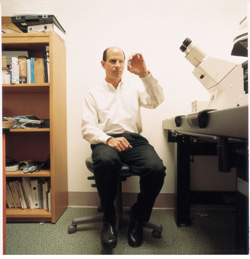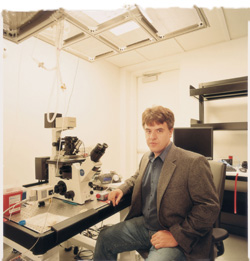A quick look at the latest developments from Stanford University Medical Center
![]() A
key to stopping allergies and asthma?
A
key to stopping allergies and asthma?
![]() Drug
recycling?
Drug
recycling?
![]() Med
ed 2.0
Med
ed 2.0
![]() Out,
weird protein
Out,
weird protein
![]() Brainiacs
Brainiacs
![]() Library
flashback
Library
flashback
A key to stopping allergies and asthma?
The sneezing and runny nose common to allergy attacks are annoying. But when the allergic response leads to diseases like asthma, it can be deadly. The problem lies not with the invading allergens so much as with the body’s defending mast cells — the sometimes overzealous gatekeepers of a host of biological mediators normally released in abundance only to combat parasites or bacteria.
Calef Brown |
|
 |
|
Now medical school researchers have discovered a long-sought “missing link” in the maturation process of mast cells that might lead to new approaches in treating allergic diseases.
Mast cells, a critical part of the immune system, develop from blood-forming stem cells that originate in bone marrow and finish maturing in tissues such as the skin, intestines and respiratory tract. Antibodies perched on mature mast cells sense invading allergens, triggering an allergic response. Allergens injected in a bee sting, for example, prompt mast cells to release histamine, which combats the effect of the sting, but causes tissue at the sting site to swell and itch. If too much histamine is released, an antihistamine is needed to reduce the irritation.
In healthy adults, mast cells are found in low numbers in tissues. But that changes when asthma or some other chronic disease affects tissue.
“One of the amazing things about mast cells is that they increase in number very quickly,” says Ching-Cheng Chen, PhD, postdoctoral scholar in pathology and first author of the paper published in the July 8, 2005, online edition of Proceedings of the National Academy of Sciences. In asthma-affected tissue, the population can double or triple, says Stephen Galli, MD, professor and chair of the Department of Pathology, one of two senior authors of the paper.
How such rapid increases happen was puzzling, but the missing link — called the mast cell progenitor — might provide an answer. Progenitors might be present, but dormant, wherever mature mast cells reside. When stimulated, they finish maturing and unleash the appropriate mediator from within. And though mature mast cells don’t normally circulate in the blood, progenitors might, and could quickly flock to a site to finish maturing
Knowing how to spot mast cell progenitors might aid in developing more effective treatments for diseases like asthma. “If we can block increases in mast cell numbers … the total number of mast cells will be low,” says Chen. This in turn would keep the release of mediators low, preventing potentially dangerous reactions. —
The research was supported by grants from the National Institutes of Health and by a C.J. Martin fellowship.— LOUIS BERGERON
| ![]() Back
to Top |
Back
to Top |
Drug recycling
Four medical students walked the halls of California’s state Capitol last May, desperately seeking state Sen. Joe Simitian (D-Palo Alto). They were there for a Senate Health Committee hearing on a bill they had set in motion in 2004. And one of them, Josemaria Paterno, was set to testify.
Misty Keasler |
|
 |
|
|
“It was like your worst nightmare,” recalls second-year medical student Emiley Chang. “It turned out we had gotten the wrong room number. We did find the senator eventually.”
With Gov. Arnold Schwarzenegger’s signing of the bill this fall, the nightmare is all but forgotten.
The new law lets pharmacies dispense previously sold, unexpired and unopened prescription medications to patients, especially those with low incomes or severe disabilities.
Use for the unused
The law got its start in last year’s Practice of Medicine course, when second-year medical student Paterno convinced four classmates to propose the law to Simitian as a class project. Nine other states have enacted similar laws since 2001, and the students thought California should join them.
Every year California health facilities such as nursing homes dispose of as much as $100 million in medications that were prescribed to someone but never used, either because that person no longer needed or wanted the drug or because he or she passed away.
The students developed a proposal and entered it in Simitian’s annual “There Oughta Be a Law” contest that invites Californians to propose ideas for new legislation.
Simitian then submitted a bill to the state senate on behalf of the students. “Many senators had the reaction I had at first: ‘You want to do what?’” says Simitian.
“Recycling drugs sounds strange, but Jose did a great job of explaining the concept.”
The proposal seemed set to sail through the legislature without a hitch until August, when Simitian learned that the Department of Health Services was opposing it.
Paterno wrote a letter to Schwarzenegger supporting the bill and e-mailed Stanford faculty, asking them to sign on. The goal was to show the governor that the bill was backed by eminent medical experts, says Paterno.
Among the responders were Dean Philip Pizzo, MD, and the senior associate dean for medical education, Julie Parsonnet, MD. “They were really influential,” says Paterno. “After that I was able to recruit most of the other senior associate deans to jump on board.”
Two days after the letter arrived at the governor’s office, he announced he would sign the bill.
Now that the legislation has become law, Paterno is focused on collaborating
with Santa Clara and San Mateo counties to implement the program. “I really want to help them establish successful and sustainable redistribution programs and encourage as many nursing homes and other health facilities as possible to participate,” he says. — ROSANNE
SPECTOR
| ![]() Back
to Top |
Back
to Top |
Med ed 2.0
This winter, School of Medicine leaders are considering design plans for a 120,000-square-foot building that will be the gateway to the School of Medicine and serve as the hub for all of its educational activities.
The goal is to build a state-of-the-art center for medical education, with innovative classroom facilities, a major conference center and a largely digitized library that will give students the flexibility to study in various locations throughout the building.
The new facility, to be called the Learning and Knowledge Center, will rise on the site of the current Fairchild Auditorium and will include three floors and a “penthouse” level where students can study in a quiet setting with views of the hills. If plans proceed as hoped, the school will break ground on the project in late 2007 and open in late 2009.
Medical magnet
“The Learning and Knowledge Center will serve as a portal and magnet for our students, post-graduate trainees, faculty and community,” says Dean Philip Pizzo, MD.
The building’s basement floor will house a conference center with a 350-seat auditorium and smaller rooms for breakout meetings. A variety of classrooms, from lecture halls to small-group discussion areas, will occupy the first floor along with executive meeting facilities and a 24-hour study and coffee area.
The second floor will have dedicated space for the Knowledge Management Center, a biomedical library with 90 percent of its core content available in digital format. “We want content digital so that faculty, staff and students are not bound to any particular place — on or off campus — to access the information they need for research, patient care and learning,” says library director Debra Ketchell.
The third floor will house the new Center for Immersive and Simulation-Based Learning, where students and even seasoned practitioners can test their clinical skills in a simulated operating room, emergency department, intensive care unit or other clinical setting.
The project will include renovations to the existing Lane and Alway buildings. The Lane basement will house the remaining print collections of the library and the historical collection. The first floor of Lane will be used for the dean’s administrative offices and the graduate services program, while the Alway renovations will include an expansion of the medical school café and student lounge area.
School officials hope to present formal designs for the new building
to the university trustees this summer. The estimated cost of the project
is $128 million. The project will be paid for through a mix of private
contributions, debt and university resources — RUTHANN RICHTER
Out, weird protein
Tumor-suppressor proteins work to inhibit tumor growth in our bodies. When they win, they spare us a battle with cancer. But one such protein, menin, appears to have a split personality. Though menin suppresses endocrine tumors, new research shows it is also a key player in the development of some forms of acute leukemia.
Calef Brown |
|
 |
|
The researchers, who made the discovery working with mouse cells, say this is the first time a tumor-suppressor protein has been found to have such a dramatic dual role.
Normally, menin binds with another protein, MLL, as part of a protein complex in the cell nucleus that guides the cell through its development. But when mutated, MLL becomes a cancer-promoting oncoprotein. This causes maturation to stall at an intermediate stage, and the immature cells begin proliferating uncontrollably. Normally the oncoprotein and tumor-suppressor protein would now be in direct conflict, but not so in some acute leukemias.
“We’ve discovered a situation where they’re not antagonizing each other’s actions, they’re actually working together,” says Michael Cleary, MD, professor of pathology and pediatrics and senior author of the paper published in the Oct. 21, 2005, issue of Cell.
Dark side of menin
Given menin’s usual effectiveness in suppressing endocrine tumors, Cleary and first author Akihiko Yokoyama, PhD, postdoctoral scholar in pathology, suspected MLL was somehow deactivating menin’s suppressive powers. They tested the theory with mouse cells in vitro, introducing mutated MLL oncoproteins and letting leukemia thrive. Yokoyama then removed menin from the cancer cells.
If menin and MLL were struggling against each other, the researchers reasoned that removing menin either would not affect the rate of proliferation, or the leukemia would run even wilder, flourishing without restraint. But the leukemia ground to a halt.
Even more unexpected was what happened next — the former cancer cells matured. Like juvenile delinquents steered from a life of crime when a bad influence is removed, the immature blood cells not only ceased their bad behavior once menin was gone, they resumed productive lives. They completed the differentiation process, becoming mature blood cells. The leukemia disappeared without a single cancer cell being killed.
Exactly what causes menin to behave as it does in acute leukemia isn’t
clear. But the stunning reversal of leukemia in the mouse cells when menin
was removed offers clues for developing treatments. If the findings can
be applied to humans, “we would probably stop a leukemia dead in
its tracks,” says Cleary. — LOUIS
BERGERON
The study was funded by the National Cancer Institute and the Lucile Packard Foundation for Children’s Health.
| ![]() Back
to Top |
Back
to Top |
Brainiacs
Misty Keasler |
|
 |
|
|
Had Ed McMahon knocked on Pehr Harbury’s door last fall and handed him a check, Harbury probably wouldn’t have been surprised.
That’s because Harbury, PhD, associate professor of biochemistry, was on a remarkable run where award money was concerned.
On Sept. 20, Harbury was among the 2005 MacArthur Fellows to win the award, often called a “genius grant,” that comes with a no-strings-attached $500,000.
Nine days later, Harbury and two other faculty members at the School of Medicine were recognized for their innovative work by the National Institutes of Health. The winners of the NIH Director’s 2005 Pioneer Awards each receive up to $500,000 annually for five years to help fund their research. With three of the 13 winners, Stanford had more awardees than any other institution.
Misty Keasler |
|
 |
|
Thomas Rando |
Harbury is trying to devise ways to use DNA molecules as blueprints for the synthesis of small chemical compounds that might be useful in drug design. He plans to use his new sources of funding for more work in that area. Specifically, he hopes to develop a quicker, cheaper approach to designing drugs. “We’re trying to put the ‘magic’ into the magic bullet of drug design,” he says.
Stanford’s two other Pioneer Award winners are Thomas Rando, MD, PhD, and Karl Deisseroth, MD, PhD. Rando, associate professor of neurology and neurological sciences, is looking for ways to enhance the potential of stem cells to compensate for the age-related decline in the body’s repair capability. His work also has the potential to help sufferers of degenerative diseases such as muscular dystrophy.
He says his research team has some data to suggest that it isn’t changes in the stem cells that reduce their ability to repair tissue with age, but changes in the niche where they reside. This is what he’ll use the award money to explore.
Misty Keasler |
|
 |
|
Karl Deisseroth |
Deisseroth, assistant professor of bioengineering and of psychiatry and behavioral sciences, wants to find ways of using high-speed bioengineering tools to augment the study of psychiatry.
Deisseroth, who earned his MD and PhD at Stanford, hopes to develop
two bioengineering tools that use high-speed flashes of light to probe
neurons. One would enable him to observe the brain’s circuitry on the millisecond time scale at which it operates. “To really understand what’s going wrong with the brain, you have to match that speed,” he says. The other tool would allow him to control brain circuitry, with the goal of understanding how to correct the abnormal circuit dynamics.— LOUIS
BERGERON
| ![]() Back
to Top |
Back
to Top |
Library flashback
The year is 2106. Stanford medical students are gathered around a mysterious box that’s been sealed for a century. A look at the contents will whisk them back 100 years to contemplate the medical school’s old soul — its library. What exactly will they find in the box? Well, that’s up to us.
Stanford’s Lane Medical Library, one of the oldest medical libraries in the West, is about to hit 100. To celebrate, Lane will host a clinical informatics symposium this winter, an open house this spring and exhibits throughout the year.
Lane also invites readers to visit its Web site to post their library memories for others to consider — and for inclusion in a time capsule.
Now for a little time traveling of our own. In 1906, the directors of the medical school’s predecessor, Cooper Medical College, founded the library, naming it after Levi Cooper Lane, the school’s co-founder. They were committed to building a great medical library. As early as 1907, with the arrival of books and journals purchased from the New York Academy of Medicine, Lane’s holdings included more than 35,000 volumes, making it the largest medical library west of Chicago.
In 1959, Lane Library moved to the Stanford campus along with the School of Medicine. Today, Lane has over 400,000 volumes and 2,300 journal subscriptions, 90-plus percent of which are online.
Visit the Lane Centennial Web site at http://lane.stanford.edu/100years. — ROSANNE SPECTOR
| ![]() Back
to Top |
Back
to Top |
Comments? Contact Stanford Medicine at

